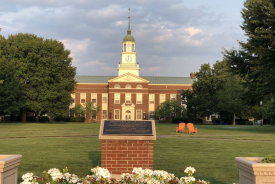Portland State Illegally Fired 10 Professors — Arbitrator Orders University to Give Them Their Jobs Back
By
WHAT YOU NEED TO KNOW:
The Ruling: Independent arbitrator ruled November 6 that Portland State University violated its union contract when laying off 10 non-tenure-track faculty members. PSU must restore their jobs and make them "whole" financially.
The Victory: Jennifer Kerns, associate history professor with nearly 25 years at PSU, is ecstatic: "I love the work that I do. I want to serve my students, and I'm happy to be able to get back in the classroom."
What Went Wrong: PSU used quick-layoff contract clause requiring detailed justification for eliminating specific programs. Arbitrator ruled university should have used lengthy economic-downturn procedure instead, and failed to provide sufficient reasoning for eliminations.
The Cost: PSU saved $12.3 million (88 full-time positions) from academic affairs cuts. Reinstating 10 jobs will eat into those savings. But that's just the beginning—PSU plans to cut $35 million more by 2027.
The Pattern: This is PSU's second labor violation in two months. October: Oregon Employment Relations Board found PSU violated state labor law withholding funds from Faculty Association members.
Union President Bill Knight: "These were all folks who had full classes. They were great contributors to PSU in all kinds of ways: research, teaching and service. To see them restored to their positions — it feels like justice."
Twenty-Five Years of Teaching, Gone in One Pink Slip
Jennifer Kerns spent nearly 25 years teaching history at Portland State University.
She loved her work. She loved her students. She was an associate professor who, by all accounts, was excellent at her job with full classes and strong student evaluations.
Last December, she got a pink slip.
PSU was closing an $18 million budget deficit and decided her position was expendable. She was one of 17 non-tenure-track faculty who received layoff notices.
The university didn't follow proper procedures outlined in the union contract, according to the faculty union PSU-AAUP. So they filed a grievance.
Ten months later, an independent arbitrator agreed with the union.
"I find the union has met its burden of proof and established that the university failed to adhere to contractual terms in laying off 10 of its non-tenure track faculty," wrote the arbitrator in her November 6 decision.
Kerns and nine other professors are getting their jobs back.
"I have had the pleasure to work in the classroom at Portland State for almost 25 years, and I love the work that I do," Kerns said. "I want to serve my students, and I'm happy to be able to get back in the classroom."
It feels like justice. Because it is justice—a rare win for faculty in an era of widespread higher education cuts.
The $18 Million Deficit PSU "Successfully" Closed
Portland State had a real problem: an $18 million budget deficit that needed closing before the end of the 2024-25 school year.
The university's solution was dramatic cuts, including laying off 17 non-tenure-track faculty members in December 2024.
From a purely financial perspective, the plan worked. PSU closed the deficit.
The university saved over $12.3 million from the academic affairs division alone—equivalent to about 88 full-time positions eliminated, according to recent financial plan documents.
Mission accomplished, right?
Not quite.
The layoffs were "extremely controversial among the university's faculty, staff and students," according to Oregon Public Broadcasting. Faculty protested the cuts, saying they weren't included in the administration's budget streamlining process.
When pink slips went out to 17 non-tenure-track faculty in December, PSU-AAUP responded with a labor grievance alleging the university violated contract procedures.
Ten months later, the arbitrator sided with the union on 10 of those cases.
The Contract Clause PSU Got Wrong
The dispute centers on two different clauses in PSU-AAUP's collective bargaining agreement that outline how the university can lay off union members.
Clause 1: The Quick Route This clause allows swift layoffs IF the university provides detailed justification for eliminating specific programs and classes.
Clause 2: The Economic Downturn Route This is a much lengthier procedure intended for use when the university is experiencing genuine financial crisis—when there's insufficient funds to pay bills.
PSU chose Clause 1—the quick route.
The arbitrator said that was wrong.
"Budgetary concerns are 'stamped' on virtually every piece of evidence in this case," the arbitrator wrote, noting that PSU's own documents made clear this was about money, not about eliminating specific unnecessary programs.
The university argued the lengthy Clause 2 process wasn't appropriate "because there has been no Presidential declaration that the university has insufficient funds to pay its bills."
But the arbitrator wasn't buying it. An $18 million deficit and mass faculty layoffs to close it clearly constitute an economic situation requiring the longer, more protective process.
Additionally, the arbitrator found PSU "failed to provide sufficient reasoning for each of the 10 layoffs in the grievance case."
Translation: PSU couldn't adequately justify why these specific 10 faculty members were fired rather than others, or why their positions were truly unnecessary.
"These Were All Folks Who Had Full Classes"
Bill Knight, president of PSU-AAUP, emphasized that the laid-off faculty weren't deadweight or underperforming professors.
"These were all folks who had full classes. They were great contributors to PSU in all kinds of ways: research, teaching and service," Knight said.
They were teaching classes students needed. They were conducting research. They were serving on committees and contributing to university governance.
And they were let go not because their work wasn't valuable, but because the university decided it could operate with fewer faculty members.
"To see them restored to their positions — it feels like justice," Knight said.
The victory is particularly meaningful because non-tenure-track faculty have minimal job security and are often the first to be cut during financial difficulties.
PSU's Response: "Misguided Interpretation"
Portland State isn't happy about the ruling.
A university spokesperson said the arbitration decision "is based on a misguided interpretation of the contract agreement."
The spokesperson emphasized PSU's challenges: "PSU is facing the challenge of continuing to offer an excellent and affordable education despite reduced enrollment and other economic headwinds."
And they struck a conciliatory note: "We greatly value every member of our faculty and staff and are striving to work together toward a sustainable and vibrant future for the university."
But the university is considering an appeal of the binding arbitration decision—suggesting PSU doesn't actually accept the ruling, even though arbitration decisions are typically final.
The tension is clear: PSU wants flexibility to make cuts quickly without lengthy procedures. The union wants the university to follow the contract both parties signed.
The Second Labor Violation in Two Months
Here's what makes this particularly embarrassing for Portland State: this is the university's second labor violation in as many months.
Last month, the Oregon Employment Relations Board found PSU violated state labor law when it withheld certain funds meant for Portland State University Faculty Association members.
Two separate labor violations. Two separate rulings against the university. Two separate findings that PSU doesn't follow the rules when dealing with its employees.
That's not just bad luck or misunderstanding. That's a pattern.
As Knight diplomatically put it: "[The decision] forces the university to respect the concept of shared governance. It's a reminder to the university that they can't simply make arbitrary administrative decisions without involving the faculty."
Translation: Stop breaking the law and violating contracts.
What "Made Whole" Actually Means
The arbitrator's decision requires PSU to restore the 10 faculty members to their previous positions and make them "whole."
In labor law, "made whole" means:
- Restoring the job they had
- Back pay for all wages lost since termination
- Restoration of benefits (health insurance, retirement contributions, etc.)
- Possible compensation for damages (emotional distress, professional harm, etc.)
For faculty who've been unemployed or underemployed for 10 months, this could mean significant back pay.
It also means PSU's $12.3 million in savings from academic affairs cuts just got smaller—potentially significantly smaller once all costs are calculated.
But the bigger impact is on university credibility. How do you recruit faculty when you have two labor violations in two months? How do you maintain morale when everyone sees the university breaking its own contracts?
The $35 Million Problem Nobody's Talking About
Here's the uncomfortable reality: restoring 10 jobs might feel like justice, but it doesn't solve PSU's financial problems.
Earlier this year, Portland State announced plans to cut an additional $35 million from its operating budget by 2027.
That's on top of the $18 million already cut.
PSU-AAUP members know more faculty cuts are inevitable.
"[The decision] forces the university to respect the concept of shared governance," Knight said, adding hope that future cuts will be handled more thoughtfully with faculty involvement.
But the math is brutal: $35 million in additional cuts means more jobs lost, more programs eliminated, more students impacted.
The arbitration victory saves 10 jobs today. But how many more will be lost tomorrow?
Why Portland State Is in This Mess
PSU's budget crisis stems from multiple factors:
Enrollment Decline: Fewer students = less tuition revenue. This is hitting regional comprehensive universities particularly hard.
State Funding Cuts: Oregon's support for higher education has declined as a percentage of university budgets over decades, shifting more costs to students.
Rising Costs: Healthcare, facilities maintenance, technology infrastructure, and competitive faculty salaries all cost more.
Pandemic Impact: COVID disrupted enrollment patterns and accelerated existing trends toward online education and questioning the value of college degrees.
Mission Challenges: As an urban-serving public university, PSU serves many first-generation, low-income, and underrepresented students—precisely the populations most price-sensitive and most affected by economic headwinds.
These are real problems requiring real solutions. But cutting faculty positions—especially illegally—isn't a sustainable solution.
The Shared Governance Fight
At the heart of this dispute is the concept of "shared governance"—the idea that faculty should have meaningful input into university decisions, especially those affecting academic programs.
Faculty aren't demanding veto power over budget decisions. They're asking to be consulted, to understand the reasoning, to help identify alternatives.
When PSU made cuts last year, faculty said they were excluded from the process. They didn't see budget details. They didn't have input on which positions to eliminate. They just got pink slips.
The arbitration ruling doesn't just restore 10 jobs. It reinforces that universities can't ignore their own contracts and make "arbitrary administrative decisions without involving faculty," as Knight put it.
What This Means for Other Universities
Portland State's situation isn't unique. Universities nationwide face similar pressures:
- Enrollment declines
- Budget deficits
- Pressure to cut costs
- Tension between administrators and faculty
The PSU arbitration decision sends a message to other institutions: you can't violate your union contracts just because money is tight.
It also demonstrates that faculty unions can win—even against universities with much more resources and legal firepower.
For the hundreds of non-tenure-track faculty at institutions nationwide wondering if they're next on the chopping block, PSU's ruling offers a glimmer of hope: contracts matter, procedures matter, and sometimes faculty win.
What Happens Next
Short Term:
- PSU must restore 10 faculty positions
- University must calculate and pay back wages and benefits
- PSU decides whether to appeal (despite ruling being binding)
Medium Term:
- PSU implements $35 million in additional cuts through 2027
- Faculty brace for more layoffs—hopefully handled properly this time
- Enrollment trends determine how deep future cuts must go
Long Term:
- Oregon considers whether to increase higher education funding
- PSU redesigns itself for a smaller, more sustainable scale
- Faculty unions remain vigilant about contract enforcement
For now, Jennifer Kerns and nine colleagues are celebrating. They get to return to the classrooms they love, teaching the students they're passionate about serving.
"I'm happy to be able to get back in the classroom," Kerns said.
That happiness is tempered by the knowledge that more cuts are coming. But today, at least, these 10 professors have jobs again.
And PSU has learned—or should have learned—that you can't just fire people without following your own contracts.
Even when money is tight. Even when the budget is dire. Even when cutting faculty seems like the easiest path forward.
You still have to follow the rules.
The Bottom Line
Portland State University violated its union contract when laying off 10 non-tenure-track faculty members to close an $18 million budget deficit.
An independent arbitrator ruled the university used the wrong contract procedure and failed to adequately justify the specific layoffs.
The 10 professors—including Jennifer Kerns, who served PSU for nearly 25 years—will be restored to their positions and made financially whole.
This is PSU's second labor violation in two months, revealing a pattern of disregarding contractual obligations when dealing with employees.
The victory feels like justice for the laid-off faculty. But with $35 million more in cuts planned by 2027, the broader crisis continues.
As union president Bill Knight said: "It's a reminder to the university that they can't simply make arbitrary administrative decisions without involving the faculty."
Sometimes the rules actually matter. Sometimes contracts actually mean something. Sometimes faculty actually win.
This is one of those times.
© 2025 University Herald, All rights reserved. Do not reproduce without permission.








